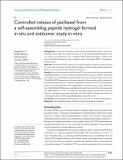Controlled release of paclitaxel from a self-assembling peptide hydrogel formed in situ and antitumor study in vitro
Author(s)
Liu, Jingping; Zhang, Lanlan; Yang, Zehong; Zhao, Xiaojun
DownloadLiu-2011-Controlled release of.pdf (3.370Mb)
PUBLISHER_CC
Publisher with Creative Commons License
Creative Commons Attribution
Terms of use
Metadata
Show full item recordAbstract
Background: A nanoscale injectable in situ-forming hydrogel drug delivery system was developed in this study. The system was based on a self-assembling peptide RADA16 solution, which can spontaneously form a hydrogel rapidly under physiological conditions. We used the RADA16 hydrogel for the controlled release of paclitaxel (PTX), a hydrophobic antitumor drug.
Methods: The RADA16-PTX suspension was prepared simply by magnetic stirring, followed by atomic force microscopy, circular dichroism analysis, dynamic light scattering, rheological analysis, an in vitro release assay, and a cell viability test.
Results: The results indicated that RADA16 and PTX can interact with each other and that the amphiphilic peptide was able to stabilize hydrophobic drugs in aqueous solution. The particle size of PTX was markedly decreased in the RADA16 solution compared with its size in water. The RADA16-PTX suspension could form a hydrogel in culture medium, and the elasticity of the hydrogel showed a positive correlation with peptide concentration. In vitro release measurements indicated that hydrogels with a higher peptide concentration had a longer half-release time. The RADA16-PTX hydrogel could effectively inhibit the growth of the breast cancer cell line, MDA-MB-435S, in vitro, and hydrogels with higher peptide concentrations were more effective at inhibiting tumor cell proliferation. The RADA16-PTX hydrogel was effective at controlling the release of PTX and inhibiting tumor cell growth in vitro.
Conclusion: Self-assembling peptide hydrogels may work well as a system for drug delivery.
Date issued
2011-09Department
Massachusetts Institute of Technology. Center for Biomedical EngineeringJournal
International Journal of Nanomedicine
Publisher
Dove Medical Press
Citation
Liu, Jingping, Lanlan Zhang, Zehong Yang, and Xiaojun Zhao. “Controlled Release of Paclitaxel from a Self-Assembling Peptide Hydrogel Formed in Situ and Antitumor Study in Vitro.” International Journal of Nanomedicine (September 2011): 2143.
Version: Final published version
ISSN
1178-2013
1176-9114